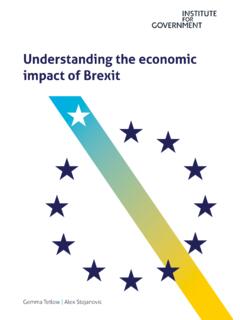Transcription of The European Union: Ongoing Challenges and Future Prospects
1 The European Union: Ongoing Challenges and Future Prospects Updated December 3, 2018. Congressional Research Service R44249. The European Union: Ongoing Challenges and Future Prospects Summary The European Union (EU) is a unique partnership in which member states have pooled sovereignty in certain policy areas and harmonized laws on a wide range of economic and political issues. The EU is the latest stage in a process of European integration begun after World War II, initially by six Western European countries, to promote peace, security, and economic development.
2 The EU currently consists of 28 member states, including most of the formerly communist countries of Central and Eastern Europe. The EU is largely viewed as a cornerstone of European stability and prosperity. For much of the last decade, however, many EU countries have faced considerable economic difficulties. Despite an improved economic situation in the EU since 2017, economic pressures and societal changes have contributed to the rise of populist and antiestablishment political parties, at least some of which harbor anti-EU or euroskeptic sentiments.
3 Such trends have complicated the EU's ability to deal with multiple internal and external Challenges . Among the most prominent Challenges are the pending departure of the United Kingdom (UK) from the EU ( brexit );. democracy and rule-of-law concerns in Poland, Hungary, and other EU members;. migration and related societal integration concerns;. a resurgent Russia; and a heightened terrorism threat. Amid these difficult issues, some are questioning the Future shape and character of the EU. Supporters of the EU worry that certain aspects of EU integration could be stopped or reversed.
4 Others contend that the multiple crises could produce some beneficial reforms and ultimately transform the EU into a more effective, cohesive entity. Recently, considerable attention has focused on developing a multispeed EU, in which some EU members could pursue greater integration in specified areas while others could opt out. Successive Administrations and many Members of Congress have supported the European integration project since its inception, viewing it as crucial to European peace and security and as a way to foster strong allies and trading partners.
5 Despite some tensions over the years, the United States and the EU share a dynamic political partnership on various foreign policy issues and an extensive trade and investment relationship. How the EU evolves in the years ahead may have strategic and economic repercussions for the United States. At the same time, some EU leaders are concerned about President Trump's apparent skepticism of the EU and his reported assessment of the bloc as an economic competitor. Those of this view also worry that elements of the Trump Administration's America First foreign policy such as the decision to withdraw from the 2015 multilateral nuclear deal with Iran pit the United States against the EU.
6 A number of European officials and analysts question whether traditional support for close relations may be shifting and whether the United States will remain a reliable international partner. Some observers suggest that managing relations with the United States under the Trump Administration has emerged as another, somewhat unexpected, challenge for the EU. At the same time, many in the EU hope to preserve close ties and EU policymakers continue to seek to cooperate with the Trump Administration where possible on issues of common interest and concern.
7 This report provides a brief history of the EU and the major Challenges confronting the bloc. It also discusses the potential implications for the EU and for relations. Also see CRS. Report RS21372, The European Union: Questions and Answers, by Kristin Archick. Congressional Research Service The European Union: Ongoing Challenges and Future Prospects Contents Overview .. 1. Evolution of the European Integration Project and Internal Dynamics .. 3. The Past as Prologue .. 3. Inherent Differences and Persistent 4.
8 Current Political and Economic Context .. 5. Improving Economies but Lingering Concerns .. 5. Rise of Anti-EU or Euroskeptic Political Parties .. 7. Lack of Strong Leadership and Decreased Solidarity .. 8. Simultaneous 9. The UK Decision to Leave the 9. Democracy and Rule-of-Law Concerns .. 11. Migratory Pressures and Societal Integration Challenges .. 13. European Security Concerns .. 16. Managing a Resurgent Russia .. 16. Countering Terrorism .. 18. Possible Future Scenarios for the EU and Next Steps .. 20. Issues for the United States.
9 22. Policy Considerations .. 22. Does the United States Pose a Challenge for the EU? .. 23. Figures Figure A-1. European Union (EU) Member States and Aspirant 26. Tables Table 1. Current Membership in the EU, Eurozone, and Schengen Area .. 2. Appendixes Appendix. Map of the EU and Candidate Countries .. 26. Contacts Author 26. Congressional Research Service The European Union: Ongoing Challenges and Future Prospects Overview The European Union (EU) is a political and economic partnership that represents a unique form of cooperation among sovereign states.
10 It is the latest stage in a process of European integration begun after World War II, initially by six Western European countries, to promote peace and economic recovery. Its founders hoped that by pooling sovereignty in certain sectors (primarily economic ones at first), integration would foster interdependence and make another war in Europe unthinkable. The EU currently consists of 28 member states, including most of the formerly communist countries of Central and Eastern Europe (see map in the Appendix). The EU has been built through a series of binding treaties, and has characteristics of both a supranational entity (in specified areas, sovereignty is shared and EU institutions hold executive authority) and an intergovernmental organization (in other areas, cooperation is based on consensus among the member state governments).















